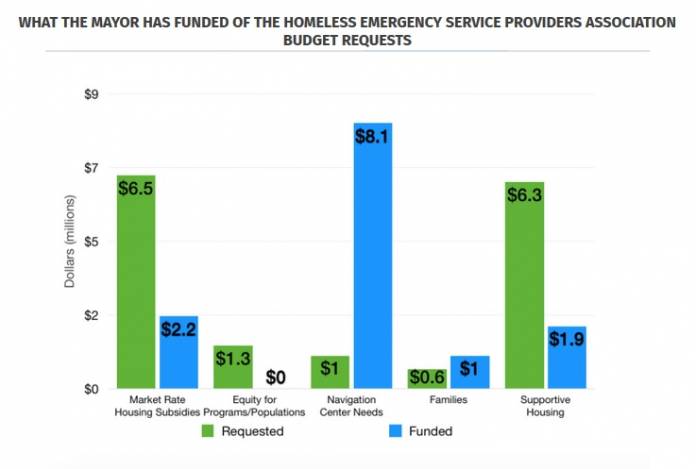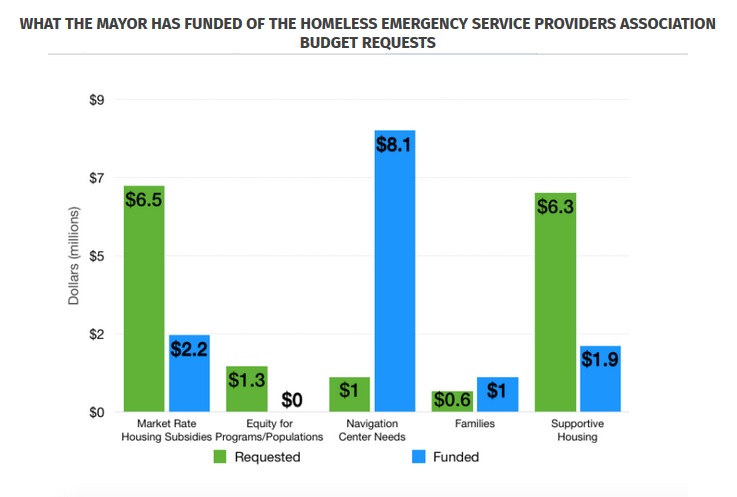
Three months ago, a team of homeless service providers sent the city a proposal for housing San Francisco residents without a home and keeping others housed.
On June 1, Mayor Ed Lee replied. The response was essentially, “yes to some, no to others.”

The Homeless Emergency Service Providers Association asked for $22 million over two years to go toward housing and homeless support systems. Most of the funding requests involved the following: expansion of market-rate housing subsidies, equity for programs and populations, needs for the Navigation Centers, provision of shelter and hotel vouchers so that no family is left outdoors, and maintaining supportive housing.
Earlier this month, Lee announced the city’s proposed budget for the 2017-18 and 2018-19 fiscal years. Overall, he is investing $27 million in new general fund money for the first year and $32 million in the second. But as far as HESPA’s requests, just $2.5 million of the $9.5 million request will be funded in the first year; another $2.5 million out of $14.8 million will be for the second year. In total, some $20 million in funding asks will be unmet.
According to a Coalition on Homelessness analysis of the potential city budget, “The primary solution to homelessness is housing – and while that may not cure poverty, it does give people a fighting chance to address anything else going on in their lives.”
Out of its $10 billion budget, San Francisco spends less than 3 percent on homeless services — and that proportion is unlikely to change.
The Board of Supervisors will tinker with the details — such as re-allocating money to cover previously unfunded items — and produce a final budget for Lee to approve and sign by the middle of July. For the upcoming budget, the supervisors have about $20 million to move around from other departments.
Some areas appear to be covered for the next two years. For example, lease and payroll increases in permanent supportive housing might get $5.2 million.
Help us save local journalism!
Every tax-deductible donation helps us grow to cover the issues that mean the most to our community. Become a 48 Hills Hero and support the only daily progressive news source in the Bay Area.
While there was no specific request from HESPA on the expansion of temporary shelters, these facilities could receive $17.4 million. As a result, new navigation centers on Jessie Street, South Van Ness Avenue and an undetermined replacement site for the South Van Ness facility will expand capacity to 416 beds by June 2018.
When Lee unveiled the proposed budget, the navigation centers were presented as centerpieces of his homelessness strategy. Funded with $14.3 million, the centers account for 27 percent of new expenditures. However, these centers act as low-barrier shelters that offer respite for people in encampments, but the existing one on Mission Street is limited to 30-day stays, so for a while hasn’t provided clients any exits to permanent housing. The new one on So Van Ness that is funded by mayor will have longer stays and housing connected to it for at least some of the clients.
Also, a 30-family emergency shelter will run at the former site of the Salvation Army-run Harbor House. However, city funding for Harbor House will only make up for federal funding that the house lost. At the same time, the family shelter at First Friendship Institutional Baptist Church runs without showers and storage. A request from HESPA for a replacement family shelter and emergency hotel vouchers did not get funded, despite the dire situation for families who have been waiting months for stable shelter only to be told they will likely never get it.
But that wasn’t the only HESPA request that won’t see a penny. A proposed 100-bed shelter in the Bayview district won’t be funded , nor would any case management in the neighborhood and remedies for disparities in single-adult shelters. The Bayview has 40 percent of the homeless population, but only 7 percent of services, a striking disparity for the mostly African American residents who are suffering without a place to lie down.
For the 2017-2018 budget year, at least $4 million will be spent subsidizing rental costs for vulnerable populations. But some particular groups will be served more than others.
Some short-term subsidies and street based-service funds are available for transition-aged youth; they will be added for $906,000, keeping some current subsidies and adding 20 more— but not for deep, need-based subsidies. Also, no cash is forthcoming for other housing subsidies, such as rapid re-housing for single adults.
Family subsidies will continue because the budget maintains current program funding. As such, 150 new and continuing subsidies will be funded through both years for a total of $3 million.
The same can’t be said for elderly and disabled adults, whose program has moved the department serving them, or for undocumented people and transgender people. While some general programs might help some in those special populations, others are likely to be left out.
Under the mayor’s plan, almost 100 behavioral health beds for people in psychiatric crisis might be added, through combined city and state funding. An SF General Hospital building known as “Hummingbird” will hold 15 of these beds.
Curiously, the mayor’s budget proposal has expenditures that have no identified sites — at least, not yet. One is the replacement for the South Van Ness Navigation Center after it stops operating; the other is a planned 24-hour drop-in center.
The mayor’s proposed budget makes some important investments in homeless services and housing subsidies, and we are grateful for these investments. The safety net for homeless San Franciscans is in tatters, however, as is evidenced on our streets and in our shelter system. The Board of Supervisors has the opportunity this month to do more in the upcoming fiscal year to alleviate suffering and increase support and dignity through adding rental assistance and emergency services, and we should take action to repair our tattered safety net now, while people on the streets are suffering.
This article first appeared in the Street Sheet.

